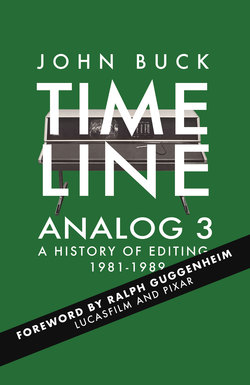Читать книгу Timeline Analog 3 - John Buck - Страница 19
На сайте Литреса книга снята с продажи.
WEBER, UBILLOS & EDELMAN
ОглавлениеCommodore Computer released the Commodore 64. Charlie White recalls:
The Commodore 64 (gave) real computer power to those who only had about $500 to spend on such things. For video, though, in those days about the only thing the contraptions were good for was sorting various (EDL) lists. Looking for even more ways to use the things, I encouraged a few enterprising programmers to write a program called "Shot Sheets," which was designed to take a list of shots for music production and sort them into individual lists for camera people to follow during the performance.
It worked, saved the director some time and got us into the whole computer thing. Someday, maybe we could actually edit video on it??
Having grown up in a family of artists, Markus Weber was intrigued by the C 64.
The C64 offered an unbelievable 64kB of memory and a graphics card that could display 320x240 pixels in 32 colors. It was the graphics capabilities that aroused my interest.
Weber convinced his mother to finance a C64 purchase for him.
Then I virtually disappeared into my room for half a year. First I had to master the BASIC programming language of the machine, only to discover that you could not simply program graphics on this machine.
You first had to understand how the processor worked, then you had to master some much more advanced programming technique called Assembler programming, that let you directly control the registers of the CPU, which you then used to actually develop “machine language subroutines” for printing a point (a pixel), a line (a number of pixels) or a circle (a curved number of pixels) on your graphics screen.
Only once you had mastered these primitives, could you start looking for doing more advanced stuff in “high-level” BASIC. There was absolutely nothing available on how to create such a 3D grid, how to mathematically program the rotations, how to “project” the abstract model to the screen and how to remove hidden lines (or to be more precise, how to avoid painting them, because removing them might remove visible lines as well). So I holed-up with my 2 years of math majors and worked it all out for myself over the course of 3 months.
Weber contacted other geeks and built a small library of graphics-based computer games.
Today you would call it a social network, for us it was just a way of getting new games for free by ways of trading. What we didn’t know, what no one knew by the time, these things made you addicts and I became one of the worst.I would get up, have some coffee, then get in front of the machine to figure out my 3D stuff, barely stopping for food once in a while and then switching to gaming by 6pm, to continue hunting the latest high-score until 3am the next day. My god, was my mother mad at me.
Randy Ubillos was studying computer engineering at the University of Miami. He continued to write and sell programs for Commodore computers in his spare time.
I only lasted three years at college because I was just so bored and not at all challenged and although my parents were freaked out at first, I left college and went into the software business full-time.
Ubillos started Computer Applications Inc. with Steve Pierce in Raleigh, NC to handle contract programming. With a team that included David Dixon and Emilio Sotolongo, they created the Key-Quest 64 and Super Black Belt Karate C64 games.
The programs and projects that I was doing with our business were way more advanced than anything I was learning at school.
Steve Edelman studied electrical engineering at Cornell University located in Ithaca, New York. He poured over hobbyist computers and the fledgling PC industry’s newsletters.
I built my own CPU. It had a hand etched PC board, a hand-bent metal case, a hand-wired transformer, a block of aluminum I machined to make a paper-tape reader, and 1K of memory. By the spring of my senior year in college it finally ran. I was hooked.
Edelman started his own personal computer company, Ithaca Intersystems, shortly after graduating. He and fellow Cornell alum worked in a small rented space in the Collegetown neighborhood where they had a moderate success with a Zilog Z80-based computer.
Zilog had been founded by Federico Faggin who had led the design and development of the world's first microprocessor, the Intel 4004,
John Markhoff explained in a New York Times profile:
Just as Steve Jobs had phoned David Packard, then chief executive of Hewlett-Packard, to ask for parts for the original Apple computer, Edelman called Mr. Faggin to ask him for a microprocessor chip to help get him started.
Ithaca Intersystems moved to larger offices outside of town and released a Z8002-based machine at almost the same time as the microcomputer industry fizzled out. Edelman spent several years flying around the world as a messenger for courier services before returning to the US.
